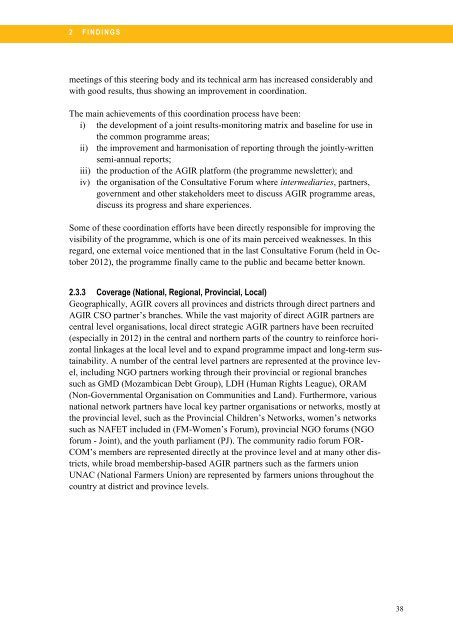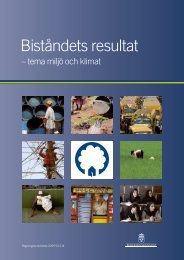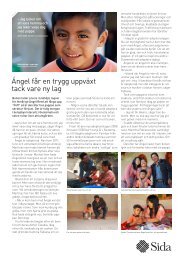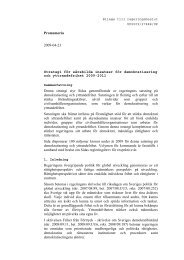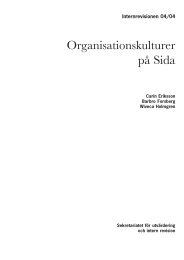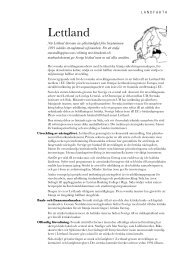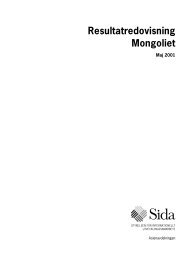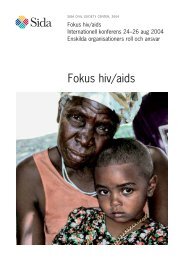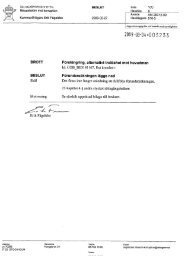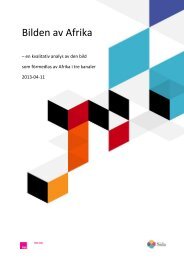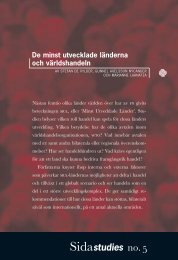Mid-Term Review of the AGIR Programme - Sida
Mid-Term Review of the AGIR Programme - Sida
Mid-Term Review of the AGIR Programme - Sida
You also want an ePaper? Increase the reach of your titles
YUMPU automatically turns print PDFs into web optimized ePapers that Google loves.
2 F I N D I N G S<br />
meetings <strong>of</strong> this steering body and its technical arm has increased considerably and<br />
with good results, thus showing an improvement in coordination.<br />
The main achievements <strong>of</strong> this coordination process have been:<br />
i) <strong>the</strong> development <strong>of</strong> a joint results-monitoring matrix and baseline for use in<br />
<strong>the</strong> common programme areas;<br />
ii) <strong>the</strong> improvement and harmonisation <strong>of</strong> reporting through <strong>the</strong> jointly-written<br />
semi-annual reports;<br />
iii) <strong>the</strong> production <strong>of</strong> <strong>the</strong> <strong>AGIR</strong> platform (<strong>the</strong> programme newsletter); and<br />
iv) <strong>the</strong> organisation <strong>of</strong> <strong>the</strong> Consultative Forum where intermediaries, partners,<br />
government and o<strong>the</strong>r stakeholders meet to discuss <strong>AGIR</strong> programme areas,<br />
discuss its progress and share experiences.<br />
Some <strong>of</strong> <strong>the</strong>se coordination efforts have been directly responsible for improving <strong>the</strong><br />
visibility <strong>of</strong> <strong>the</strong> programme, which is one <strong>of</strong> its main perceived weaknesses. In this<br />
regard, one external voice mentioned that in <strong>the</strong> last Consultative Forum (held in October<br />
2012), <strong>the</strong> programme finally came to <strong>the</strong> public and became better known.<br />
2.3.3 Coverage (National, Regional, Provincial, Local)<br />
Geographically, <strong>AGIR</strong> covers all provinces and districts through direct partners and<br />
<strong>AGIR</strong> CSO partner’s branches. While <strong>the</strong> vast majority <strong>of</strong> direct <strong>AGIR</strong> partners are<br />
central level organisations, local direct strategic <strong>AGIR</strong> partners have been recruited<br />
(especially in 2012) in <strong>the</strong> central and nor<strong>the</strong>rn parts <strong>of</strong> <strong>the</strong> country to reinforce horizontal<br />
linkages at <strong>the</strong> local level and to expand programme impact and long-term sustainability.<br />
A number <strong>of</strong> <strong>the</strong> central level partners are represented at <strong>the</strong> province level,<br />
including NGO partners working through <strong>the</strong>ir provincial or regional branches<br />
such as GMD (Mozambican Debt Group), LDH (Human Rights League), ORAM<br />
(Non-Governmental Organisation on Communities and Land). Fur<strong>the</strong>rmore, various<br />
national network partners have local key partner organisations or networks, mostly at<br />
<strong>the</strong> provincial level, such as <strong>the</strong> Provincial Children’s Networks, women’s networks<br />
such as NAFET included in (FM-Women’s Forum), provincial NGO forums (NGO<br />
forum - Joint), and <strong>the</strong> youth parliament (PJ). The community radio forum FOR-<br />
COM’s members are represented directly at <strong>the</strong> province level and at many o<strong>the</strong>r districts,<br />
while broad membership-based <strong>AGIR</strong> partners such as <strong>the</strong> farmers union<br />
UNAC (National Farmers Union) are represented by farmers unions throughout <strong>the</strong><br />
country at district and province levels.<br />
38


